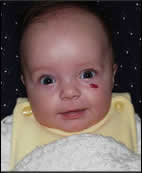What is a Vascular Birthmark?
.jpg)
Every day, many children—as many as one in 10—are born with some type of birthmark (also called a vascular anomaly). Birthmarks vary in size and can range in color from brown to blue to shades of red or pink. Although in some children a birthmark is a minor flaw that they can live with, 50-60% of all children with a birthmark will require some treatment.
At Golisano Children's Hospital, we are fortunate to have a group of specialists in the fields of dermatology, pediatric surgery, plastic surgery, interventional radiology, and otolaryngology that meet regularly to discuss our patients with vascular birthmarks. Together, they review the diagnosis and formulate a coordinated treatment plan.
There are essentially two very different type of vascular birth marks:
-
Hemangiomas
-
Vascular Malformations
Hemangioma
 Hemangiomas are benign (non-cancerous) tumors that may not be apparent at birth, but usually become visible within one to four weeks after birth. Hemangiomas usually occur on the head or neck, but they can occur anywhere, including the internal organs. The hemangioma will grow rapidly and change for the first 12 months of life and then "involute," or regress. The involution can last from three to 10 years. Typically, 70% of hemangiomas disappear by 7 years of age. However, surgical or medical treatment may be required if the hemangioma blocks off any vision or hearing, or if it interferes with breathing.
Hemangiomas are benign (non-cancerous) tumors that may not be apparent at birth, but usually become visible within one to four weeks after birth. Hemangiomas usually occur on the head or neck, but they can occur anywhere, including the internal organs. The hemangioma will grow rapidly and change for the first 12 months of life and then "involute," or regress. The involution can last from three to 10 years. Typically, 70% of hemangiomas disappear by 7 years of age. However, surgical or medical treatment may be required if the hemangioma blocks off any vision or hearing, or if it interferes with breathing.
Vascular Malformations
Vascular malformations are benign (non-cancerous) lesions. These lesions are present at birth and grow with the child. Unlike hemangiomas, vascular malformations do not have a rapid growth cycle followed by regression—they continue to slowly grow throughout life. Types of vascular malformations include:
-
Port Wine Stains. These birthmarks are present at birth, are flat, and appear pink, purple or reddish in color. They vary in size and can appear anywhere on the body. They are thought to be associated with a deficiency in the nerve supply to the blood vessels. They are more superficial and can be treated with laser therapy.
-
Venous. Often confused with a hemangioma, these malformations will always grow, are soft to the touch, and the color disappears when compressed. Most commonly found on the jaw, cheek, tongue, and lips. These lesions have low blood flow and can sometimes be injected or sclerosed.
-
Lymphatic. Formed when excess fluid accumulates within the lymphatic vessels. Lymphatic malformations are very difficult to treat but newer injection therapies are available.
-
Arteriovenous. Caused when an abnormal amount of blood goes into the capillary beds and engorges the vessels. These are high flow lesions.
Causes of Vascular Birthmarks
Currently, there are no known causes or risk factors for developing vascular birthmarks. Some initial research shows a potential genetic link, but this is inconclusive at this time.
Treatment for Vascular Birthmarks
Your child's pediatrician and treatment team will work with you and your child to determine your child's needs and determine the best course of treatment. Current treatment options include:
-
Steroid Treatment—This can be an oral medication or injected.
-
Laser surgery—Especially useful for ulceration or in combination with other treatments.
-
Surgery—Surgical removal of the lesion.
-
Radiology—For embolization or sclerosis.
-
Combinations of the above